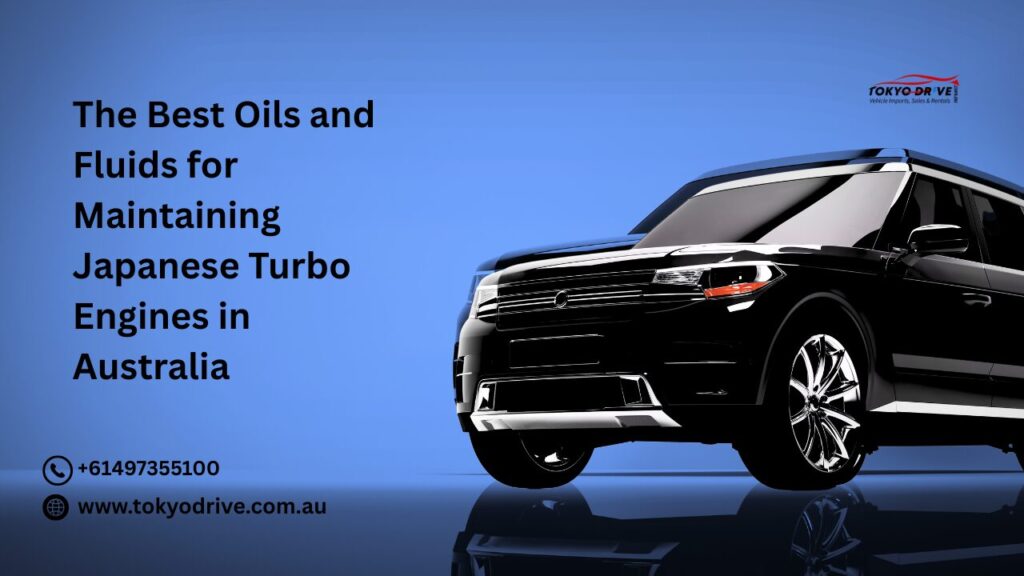Japanese turbo engines are renowned for their reliability, responsiveness, and tuning potential. But to keep them running at peak performance—especially in Australia’s hot summers and varied terrain—you need to maintain them with the right oils and fluids. Whether you’re driving a turbocharged Nissan Silvia, Subaru WRX, or Toyota Supra, what you put into your engine makes all the difference.
In this guide, we’ll explore the essential oils and fluids for your Japanese turbocharged engine and how often you should change them to ensure performance and longevity.
Why Japanese Turbo Engines Require Specialized Maintenance
Turbo engines differ significantly from naturally aspirated engines. The addition of a turbocharger increases both engine temperature and pressure, which means every fluid in the system—from oil to coolant—has to perform under greater stress. Using low-grade or incorrect fluids can result in poor performance, overheating, or even engine damage.
For imported Japanese cars in Australia, this is even more important. The local climate, road conditions, and driving styles demand that every fluid meets both manufacturer specs and Australian standards.
1. Engine Oil – The First Line of Defense
The oil in a turbocharged engine doesn’t just lubricate—it also plays a crucial role in heat dissipation. Turbochargers can spin up to 200,000 RPM and get extremely hot, so your oil must resist breaking down under heat.
Best Practices:
-
Use Fully Synthetic Oil: Synthetic oils handle heat and pressure better than conventional oils. Look for 5W-30 or 5W-40 fully synthetic blends.
-
Choose API SN/SM or ILSAC GF-6 Certified Products: These ensure the oil meets industry standards.
-
Change Every 5,000–7,000 km: More frequent changes help maintain engine integrity in high-heat situations.
Popular brands include Motul, Penrite, and Castrol EDGE, all of which offer turbo-compatible variants available across Australia.
2. Transmission Fluid – Smooth Shifting Every Time
Your transmission—whether manual or automatic—relies on high-quality fluid for proper function. In turbo cars, especially those with aggressive tuning or performance upgrades, it’s vital that the fluid resists shearing under stress.
Recommendations:
-
Manual Transmission: Use gear oils like 75W-90 GL-4 for smoother shifts and protection of synchros.
-
Automatic Transmission (ATF): Always follow the manufacturer’s specifications. Nissan, Toyota, and Subaru use proprietary ATF formulas, so stick with factory-recommended fluids unless using a verified alternative.
-
CVT Owners: Vehicles with continuously variable transmissions require specialized CVT fluid—never substitute regular ATF.
Change intervals range between 40,000–60,000 km, depending on driving style and load.
3. Differential and Transfer Case Fluids – Crucial for AWD and RWD
Japanese turbo cars like the Subaru WRX or Mitsubishi Lancer Evolution often use advanced AWD systems. These systems rely heavily on properly maintained differentials and transfer cases for even power distribution.
Key Points:
-
Use Synthetic 75W-90 for Differentials
-
For Limited Slip Differentials (LSD): Make sure the fluid is compatible with clutch-based LSDs if equipped.
-
Transfer Cases: Use the specific fluid your make/model requires—often ATF-based, but check the owner’s manual.
Replace every 30,000–50,000 km, especially if you drive spiritedly or off-road.
4. Engine Coolant – Defend Against Overheating
Australia’s climate poses a real risk to engines, especially turbocharged ones that already run hot. A high-quality coolant prevents overheating and protects the internal engine components from corrosion.
Use:
-
Long-Life Coolants (LLC): Prefer premixed coolants formulated for Japanese cars—Toyota Red, Honda Blue, or aftermarket equivalents.
-
Never Mix Coolant Colors: Different formulas can react and reduce cooling efficiency.
Flush the cooling system every 2–3 years or 40,000–50,000 km, and check for signs of discoloration or low levels every few months.
5. Brake and Clutch Fluid – Stop Confidently, Shift Cleanly
In performance cars, brake and clutch systems experience high temperatures. Over time, moisture contamination reduces the fluid’s effectiveness.
Best Practices:
-
Use DOT 4 or DOT 5.1 brake fluid for high-temperature stability.
-
Clutch Systems: Often share the brake reservoir—check and replace regularly.
Flush these systems every 12 to 18 months, especially if you drive hard or take your car to track days.

6. Power Steering Fluid – Smooth, Responsive Steering
Power steering fluids are often overlooked, but they’re essential for steering responsiveness. Some Japanese cars use ATF-style fluid, while others require proprietary blends.
Recommendations:
-
Use OEM-Approved Fluids: For example, Honda requires its own power steering fluid.
-
Inspect Hoses and Reservoirs for leaks or foamy fluid—signs of deterioration.
Change every 3 to 5 years, or sooner if you notice stiffness in the steering.
7. Fuel System Additives – Keeping Things Clean
Turbo engines need a clean fuel delivery system to operate efficiently. Over time, deposits can build up on injectors, intake valves, and combustion chambers.
Use:
-
Add Fuel Injector Cleaners every 10,000–15,000 km.
-
Choose Products designed for turbo or direct injection engines for best results.
Brands like Liqui Moly, Wynns, and Nulon offer quality fuel system cleaners widely available in Australia.

Final Thoughts
Taking care of a Japanese turbocharged engine isn’t just about performance—it’s about preservation. By using premium oils and fluids tailored to your car’s needs and Australia’s conditions, you’ll extend the life of your engine, improve reliability, and enjoy every kilometer behind the wheel.
At Tokyo Drive, we know what it takes to maintain and enhance Japanese imports in Australia. From sourcing high-quality parts to offering personalized care advice, we’re here to support your journey every step of the way.
Need help choosing the right fluids for your turbo import? Contact us, or visit our workshop for a consultation tailored to your vehicle.



